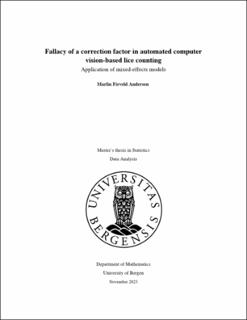| dc.description.abstract | Parasitic salmon lice (Lepeophtheirus salmonis, Krøyer 1837) are a threat to the health and welfare of farmed salmonids and to the sustainability of wild salmon populations in Norway. Accordingly, the opportunities for growth of the farming industry are strictly regulated by the Norwegian government based on the relative abundance of salmon lice in commercial sea cages. Farmers are obliged to disclose weekly lice counts per location and to perform delousing treatments when preset thresholds are exceeded. Reported lice numbers are by default based on manual counts that are obtained by physical inspection of a limited sample of fish. In recent years, advanced camera technology and artificial intelligence have made it possible to obtain image-based lice counts based on representative sample sizes and without stressful handling of the fish. However, camera-based solutions do not usually represent the entire fish. In this thesis, a correction factor between image-based and manual parasite counts in Atlantic salmon (Salmo salar, Linnaeus 1758) aquaculture is therefore being explored. The objective was to determine a factor that accurately adjusts image-based parasite counts to account for lice on the opposite site of the fish. For this purpose, simple linear models and linear mixed-effects models were developed and validated, to model manual lice counts that were reported to the Norwegian authorities. Image-based and human-verified lice counts from Stingray Marine Solutions AS of equivalent sample sizes were used as the main predictor variable. Additional predictors included farmer-reported production data such as fish counts, average fish weight, delousing treatments, and sea temperature, as well as operational data from the Stingray system, which is designed to detect, target, and eliminate sea lice on freely swimming fish by means of machine vision and laser technology. Various candidate models were compared and tested on unseen data. Results did not confirm the hypothesis that image-based counts require upward adjustment to faithfully represent the accuracy of manual counts. Instead, the resulting correction factor suggested that the opposite was the case. Statistical and procedural explanations were explored by means of simulated lice counts and are discussed with regard to current regulations. | |
